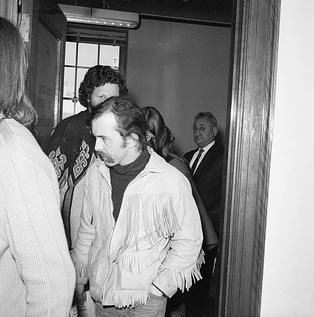
Lysergic acid diethylamide, commonly known as LSD, is a potent psychedelic drug that intensifies thoughts, emotions, and sensory perception. Often referred to as acid or lucy, LSD can cause mystical, spiritual, or religious experiences. At higher doses, it primarily induces visual and auditory hallucinations. While LSD does not cause physical addiction, it can lead to adverse psychological reactions, such as anxiety, paranoia, and delusions. Additionally, it may trigger "flashbacks," also known as hallucinogen persisting perception disorder, where individuals experience persistent visual distortions after use.

Psychedelic rock is a rock music genre that is inspired, influenced, or representative of psychedelic culture, which is centered on perception-altering hallucinogenic drugs. The music incorporated new electronic sound effects and recording techniques, extended instrumental solos, and improvisation. Many psychedelic groups differ in style, and the label is often applied spuriously.

Timothy Francis Leary was an American psychologist and author known for his strong advocacy of psychedelic drugs. Evaluations of Leary are polarized, ranging from "bold oracle" to "publicity hound". According to poet Allen Ginsberg, he was "a hero of American consciousness", and writer Tom Robbins called him a "brave neuronaut". President Richard Nixon called him "the most dangerous man in America". During the 1960s and 1970s, at the height of the counterculture movement, Leary was arrested 36 times.

Furthur is a 1939 International Harvester school bus purchased by author Ken Kesey in 1964 to carry his "Merry Band of Pranksters" cross-country, filming their counterculture adventures as they went. The bus featured prominently in Tom Wolfe's 1968 book The Electric Kool-Aid Acid Test but, due to the chaos of the trip and editing difficulties, footage of the journey was not released as a film until the 2011 documentary Magic Trip.

William Leonard Pickard is one of two people convicted in the largest lysergic acid diethylamide (LSD) manufacturing case in history. In 2000, while moving their LSD laboratory across Kansas, Pickard and Clyde Apperson were pulled over while driving a Ryder rental truck and a follow car. The laboratory had been stored near a renovated Atlas-E missile silo near Wamego, Kansas. Gordon Todd Skinner, one of the men intimately involved in the case but not charged due to his cooperation, owned the property where the laboratory equipment was stored.

2,5-Dimethoxy-4-methylamphetamine is a psychedelic and a substituted amphetamine. It was first synthesized by Alexander Shulgin, and later reported in his book PiHKAL: A Chemical Love Story. DOM is classified as a Schedule I substance in the United States, and is similarly controlled in other parts of the world. Internationally, it is a Schedule I drug under the Convention on Psychotropic Substances. It is generally taken orally.

Augustus Owsley Stanley III was an American-Australian audio engineer and clandestine chemist. He was a key figure in the San Francisco Bay Area hippie movement during the 1960s and played a pivotal role in the decade's counterculture.

The psychedelic drug lysergic acid diethylamide (LSD) was first synthesized on November 16, 1938, by the Swiss chemist Albert Hofmann in the Sandoz laboratories in Basel, Switzerland. It was not until five years later on April 19, 1943, that the psychedelic properties were found. Today, the discovery of LSD is celebrated worldwide during the annual Bicycle Day holiday, serving also as the day celebrating the psychedelic revolution in general.

The Psychedelic era was the time of social, musical and artistic change influenced by psychedelic drugs, occurring from the mid-1960s to the mid-1970s. The era was defined by the proliferation of LSD and its following influence in the development of psychedelic music and psychedelic film in the Western world.

David Earl Nichols is an American pharmacologist and medicinal chemist. Previously the Robert C. and Charlotte P. Anderson Distinguished Chair in Pharmacology at Purdue University, Nichols has worked in the field of psychoactive drugs since 1969. While still a graduate student, he patented the method that is used to make the optical isomers of hallucinogenic amphetamines. His contributions include the synthesis and reporting of escaline, LSZ, 6-APB, 2C-I-NBOMe and other NBOMe variants, and several others, as well as the coining of the term "entactogen".

ALD-52, also known as 1-acetyl-LSD, has chemical structural features similar to lysergic acid diethylamide (LSD), a known psychedelic drug. Similarly, ALD-52 has been reported to produce psychoactive effects, but its pharmacological effects on humans are poorly understood. Given its psychoactive properties, it has been reported to be consumed as a recreational drug, and the purported first confirmed detection of the substance on the illicit market occurred in April 2016.
The Brotherhood of Eternal Love was an organization of drug users and distributors that operated from the mid-1960s through the late 1970s in Orange County, California. They were dubbed the Hippie Mafia by the police. They produced and distributed drugs in hopes of starting a "psychedelic revolution" in the United States.

Nicholas Sand was a cult figure known in the psychedelic community for his work as a clandestine chemist from 1966 to 1996 for the Brotherhood of Eternal Love. Sand was part of the League for Spiritual Discovery at the Millbrook estate in New York, has been credited as the "first underground chemist on record to have synthesized DMT" and is known for manufacturing large amounts of LSD.
Walter Norman Pahnke was a minister, physician, and psychiatrist most famous for the "Good Friday Experiment", also referred to as the Marsh Chapel Experiment or the "Miracle of Marsh Chapel".

League for Spiritual Discovery (LSD) was a spiritual organization inspired by the works of Timothy Leary, and strove for legal use of lysergic acid diethylamide (LSD) for the purpose of meditation, insight, and spiritual understanding. It was in existence during the mid-to-late 1960s, and eventually closed by Leary. The New York Center for the League of Spiritual Discovery, in existence for around a year, was co-founded by Timothy Leary and Nina Graboi in 1966. The center was the first LSD-based meditation center in Manhattan.

The Acid Tests were a series of parties held by author Ken Kesey primarily in the San Francisco Bay Area during the mid-1960s, centered on the use of and advocacy for the psychedelic drug LSD, commonly known as "acid". LSD was not made illegal in California until October 6, 1966, under Governor Ronald Reagan’s administration.

Albert Hofmann was a Swiss chemist known for being the first to synthesize, ingest, and learn of the psychedelic effects of lysergic acid diethylamide (LSD). Hofmann's team also isolated, named and synthesized the principal psychedelic mushroom compounds psilocybin and psilocin. He authored more than 100 scientific articles and numerous books, including LSD: Mein Sorgenkind. In 2007, he shared first place with Tim Berners-Lee on a list of the 100 greatest living geniuses published by The Daily Telegraph newspaper.

LSD art is any art or visual displays inspired by psychedelic experiences and hallucinations known to follow the ingestion of LSD. Artists and scientists have been interested in the effect of LSD on drawing and painting since it first became available for legal use and general consumption.

Harris Isbell was an American pharmacologist and the director of research for the NIMH Addiction Research Center at the Public Health Service Hospital in Lexington, Kentucky from 1945 to 1963. He did extensive research on the physical and psychological effects of various drugs on humans. Early work investigated aspects of physical dependence with opiates and barbiturates, while later work investigated psychedelic drugs, including LSD. The research was extensively reported in academic journals such as the Journal of Pharmacology and Experimental Therapeutics, Psychopharmacologia, and the AMA Archives of Neurology and Psychiatry.

Heads: A Biography of Psychedelic America is a 2016 non-fiction book by rock journalist Jesse Jarnow. The book describes American psychedelics counterculture in the second half of the twentieth century.

















